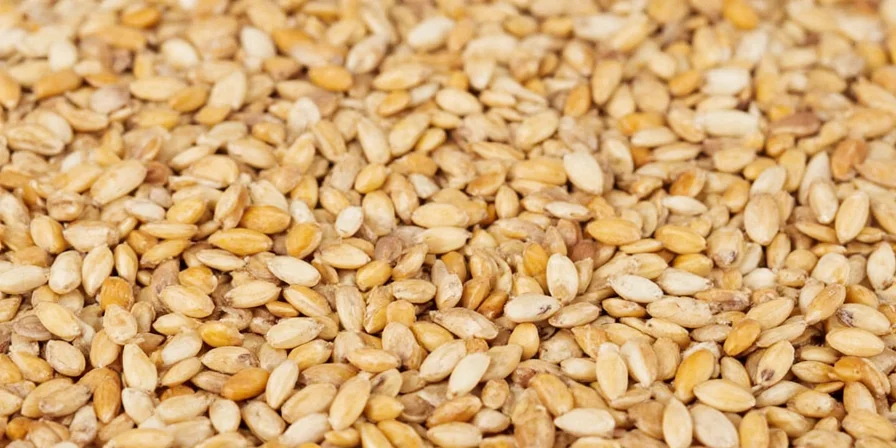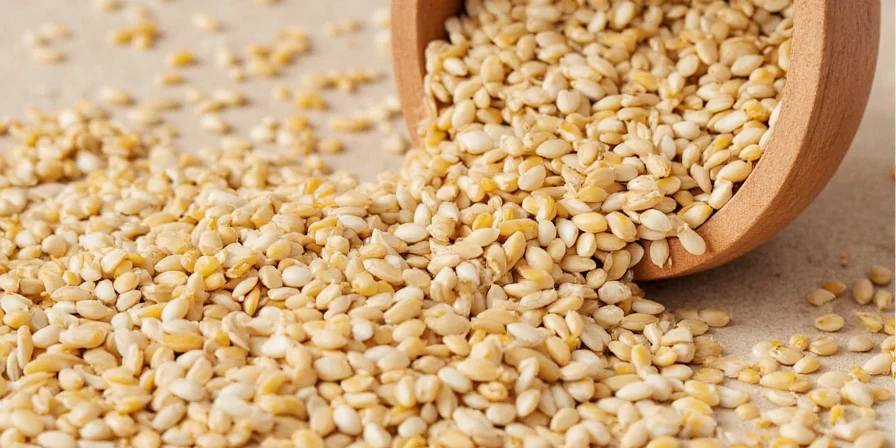
How to Toast Sesame Seeds Perfectly: The Complete Guide
For perfect toasted sesame seeds, use a dry skillet over medium-low heat. Toast 1/4 cup at a time at 325°F (163°C) for 3-4 minutes (white seeds) or 5-6 minutes (black seeds), stirring constantly until golden brown and fragrant. Listen for the first "pop" sound as a readiness indicator, then immediately transfer to a metal tray to stop cooking. This method develops maximum flavor while preventing burning.
Table of Contents
- Sesame Seed Nutrition Facts You Need to Know
- Professional Toasting Techniques for Perfect Results
- How to Store Sesame Seeds to Prevent Rancidity
- Black vs White Sesame Seeds: Key Differences
- 7 Creative Ways to Use Sesame Seeds in Cooking
- Sesame Allergy Facts and Alternatives
- Frequently Asked Questions Answered
Sesame Seed Nutrition Facts You Need to Know
One ounce (28g) of sesame seeds provides 35% of your daily calcium needs with superior bioavailability compared to many plant sources, 20% of iron (best absorbed with vitamin C), 16% magnesium, and 5g complete protein containing all nine essential amino acids. Unlike many seeds, sesame maintains nutritional value even when processed into oil or tahini.

Recent research shows sesame's unique lignans (sesamin and sesamolin) support cardiovascular health through mechanisms distinct from other oilseeds. The seed's natural antioxidants also contribute to exceptional shelf stability compared to other nuts and seeds.
Professional Toasting Techniques for Perfect Results
Proper toasting transforms sesame seeds through the Maillard reaction, creating over 150 distinct flavor compounds. Most home cooks make critical errors that lead to uneven toasting or burnt seeds.

Step-by-Step Perfect Toasting Method:
- Batch size matters: Never toast more than 1/4 cup at a time for even heating
- Temperature control: Maintain precise 325°F (163°C) - use an infrared thermometer
- Time monitoring: White seeds require 3-4 minutes; black seeds need 5-6 minutes
- Sound cues: Listen for the first audible "pop" indicating proper moisture evaporation
- Cooling technique: Transfer immediately to a metal tray to stop residual cooking
Professional chefs often use a two-stage method: initial low-temperature roast (275°F for 2 minutes) followed by high-heat finish (350°F for 1-2 minutes) for maximum flavor complexity while preserving delicate aromatic compounds.
How to Store Sesame Seeds to Prevent Rancidity
Sesame's high oil content (45-60%) requires proper storage to maintain quality. Follow these evidence-based methods:

- Whole Seeds: Store in oxygen-barrier containers at 59°F (15°C) or below. Shelf life: 12-18 months.
- Toasted Seeds: Vacuum-seal with oxygen absorbers for optimal longevity (up to 24 months).
- Tahini: Refrigerate immediately after opening; stir thoroughly before each use.
- Freezing technique: Freeze in portion-sized bags for instant use without thawing.
Store sesame seeds with bay leaves to naturally repel pantry pests. Glass containers with UV protection preserve flavor compounds better than plastic alternatives.
Black vs White Sesame Seeds: Key Differences
Understanding the biochemical differences helps choose the right variety for specific culinary applications. The color variation stems from differing phenolic compounds in the seed coat.
| Type | Appearance | Flavor Profile | Best Applications |
|---|---|---|---|
| White Sesame | Creamy white color | Mild, slightly sweet | Baking, lighter sauces, garnishing |
| Black Sesame | Raven-black, rich-looking | Nuttier, earthier, more intense | Asian desserts, traditional medicine |
| Golden/Brown Sesame | Tan to golden brown | Robust, toasted aroma | Toasting, tahini, Middle Eastern dishes |

Black sesame contains higher anthocyanins and calcium, while white varieties have more readily available amino acids. This explains why certain cuisines traditionally pair specific sesame types with particular dishes.
7 Creative Ways to Use Sesame Seeds in Cooking
Move beyond basic garnishing with these professional techniques that leverage sesame's unique chemical properties:
1. Precision Tahini Crafting
Toast seeds to 350°F (177°C) before blending for deeper flavor. Add a pinch of flaky sea salt during grinding to enhance emulsification and create smoother texture.
2. Flavor Layering Technique
Combine raw and toasted seeds in dressings for multidimensional flavor profiles—raw for subtle background notes, toasted for prominent aroma.
3. Umami Enhancement System
Blend toasted sesame with dried mushrooms and kombu to create a vegan umami booster that rivals fish-based seasonings.
4. Sesame Oil Infusion
Steep black sesame seeds in neutral oil at 140°F (60°C) for 48 hours to extract maximum flavor without bitterness.
5. Textural Engineering
Create multi-layered coatings by combining different sesame varieties with other seeds for complex textural experiences in fried foods.
6. Molecular Gastronomy Applications
Create sesame seed caviar using reverse spherification techniques for elegant appetizers that burst with nutty flavor.
7. Modern Dessert Applications
Infuse cream with black sesame for sophisticated ice creams that showcase subtle earthiness without overpowering sweetness.

Sesame Allergy Facts and Safe Alternatives
With sesame now recognized as a major allergen in the US, Canada, and EU, proper management is essential. Sesame allergy affects 0.2-0.5% of the population, with increasing prevalence.

Key considerations for allergy management:
- Cross-contamination risks in shared kitchen equipment
- Hidden sources in commercial spice blends and processed foods
- Reading international food labels where sesame may be listed differently
For safe alternatives, try pumpkin seed paste or sunflower seed butter, which provide similar texture and nutritional profiles without allergen risk.
Frequently Asked Questions Answered
What's the difference between hulled and unhulled sesame seeds?
Hulled seeds have removed outer coating, resulting in milder flavor and lighter color but reduced fiber and certain nutrients. Unhulled seeds retain more calcium and fiber but have stronger flavor. Black sesame is typically used unhulled for maximum benefit.
How do I prevent sesame oil from becoming bitter?
Bitterness develops when sesame oil is heated beyond its smoke point (350°F/177°C). For cooking, use refined sesame oil with higher smoke point. Toast seeds gently before oil extraction and store oil in dark glass containers away from light and heat.
Why does tahini separate and how can I fix it?
Natural separation occurs because sesame oil has different density than solids. Stir thoroughly before use. Adding a small amount of neutral oil during blending can improve emulsion stability. Refrigeration slows separation but makes tahini harder to stir.
Are organic sesame seeds worth the premium price?
Organic certification matters most for raw consumption, as conventional farming may use pesticides that concentrate in oil-rich seeds. For toasted applications, the difference becomes less significant as heat reduces potential pesticide residues.











 浙公网安备
33010002000092号
浙公网安备
33010002000092号 浙B2-20120091-4
浙B2-20120091-4